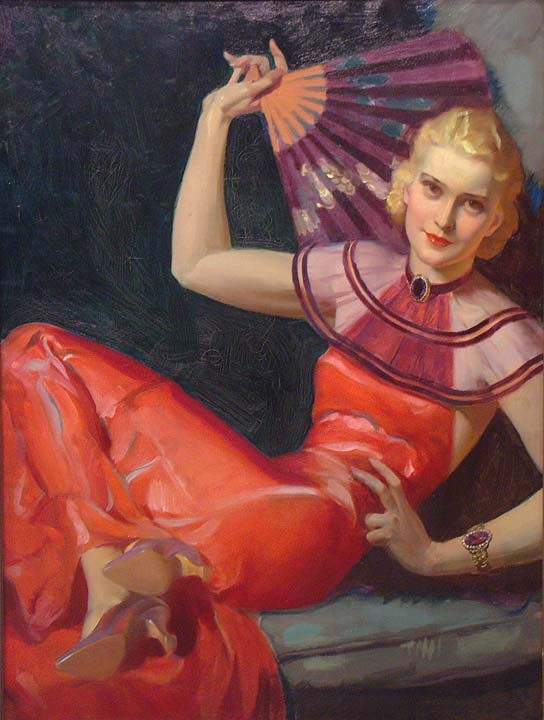

MCCLELLAND BARCLAY
"WOMAN IN RED DRESS"
THIS IS A PORTRAIT OF BARCLAY'S WIFE AND HIS MOST FAMOUS MODEL
OIL ON CANVAS, SIGNATURE OBSCURED
AMERICAN, C.1940
44 X 32 INCHES
McClelland Barclay 1891-1943 Born in St. Louis in 1891, McClelland Barclay studied first at the Art Institute of Chicago, then later at the Art Students League in New York City. He was the student of H.C. Ives, George Bridgman and Thomas Fogarty. He was a member of the Artists Guild, the Art Students League of New York and the Society of Illustrators. By the age of 21, Barclay's work had been published in The Saturday Evening Post, Ladies' Home Journal, and Cosmopolitan. Barclay was noted for his ability to paint strikingly beautiful women, boldly colored and outlined. This is perhaps best exemplified by his series for General Motors illustrating the slogan, “Body by Fisher,” and also on numerous magazine covers including: Colliers, Country Gentleman, Redbook, Pictorial Review, Coronet, Country Life, Saturday Evening Post, The Ladies’ Home Journal, Cosmopolitan, and a host of movie magazines. He began painting movie poster art for Hollywood studios during the 1930s as well, and was considered a superstar in the film industry. When in 1930, the General Motors selected McClelland Barclay’s ‘Fisher Body Girl’ for a series of advertisements, she quickly became as popular as ‘The Gibson Girl’ and ‘The Christy Girl’. He used his wife, just 19 years old, as the model for the iconic Fisher Autobody image. She later appeared in magazine advertisements and was so well published with her languid body plastered across the country on billboards, that she was recognized wherever she went. Barclay also illustrated advertisements for the A & P, Eaton Paper Company, Elgin Watches, Humming Bird Hosiery, and Lever Brothers, amongst others. His fashionable women for General Motors' "Body by Fisher" advertising campaign made his work recognizable to virtually every magazine reader in the United States. He also illustrated advertisements for Whitman's Chocolates, Texaco, and Camel and Chesterfield brand cigarettes.
Barclay did not limit himself to painting, and sculpture was another facet of the artist’s career. In the late 1930’s, Barclay set up the McClelland Barclay Art Products Corporation, a small company to reproduce jewelry and fabricate utilitarian figures for ashtrays, bookends, desk sets, lamps, and other articles for home and office use. During WWII, he was appointed a Lieutenant Commander with the US Naval Reserve. Within weeks of the Japanese attack on Pearl Harbor, Barclay completed the first of many recruiting posters for the Navy. Barclay was reported missing in action, in the Pacfic theatre, aboard an LST, which was torpedoed in the Solomon Islands. In 1944 Barclay was awarded the Art Directors Club Medal posthumously, “in recognition of his long distinguished record in editorial illustration and advertising art and in honor of his devotion and meritorious service to his country as a commissioned officer of the United States Navy.” |